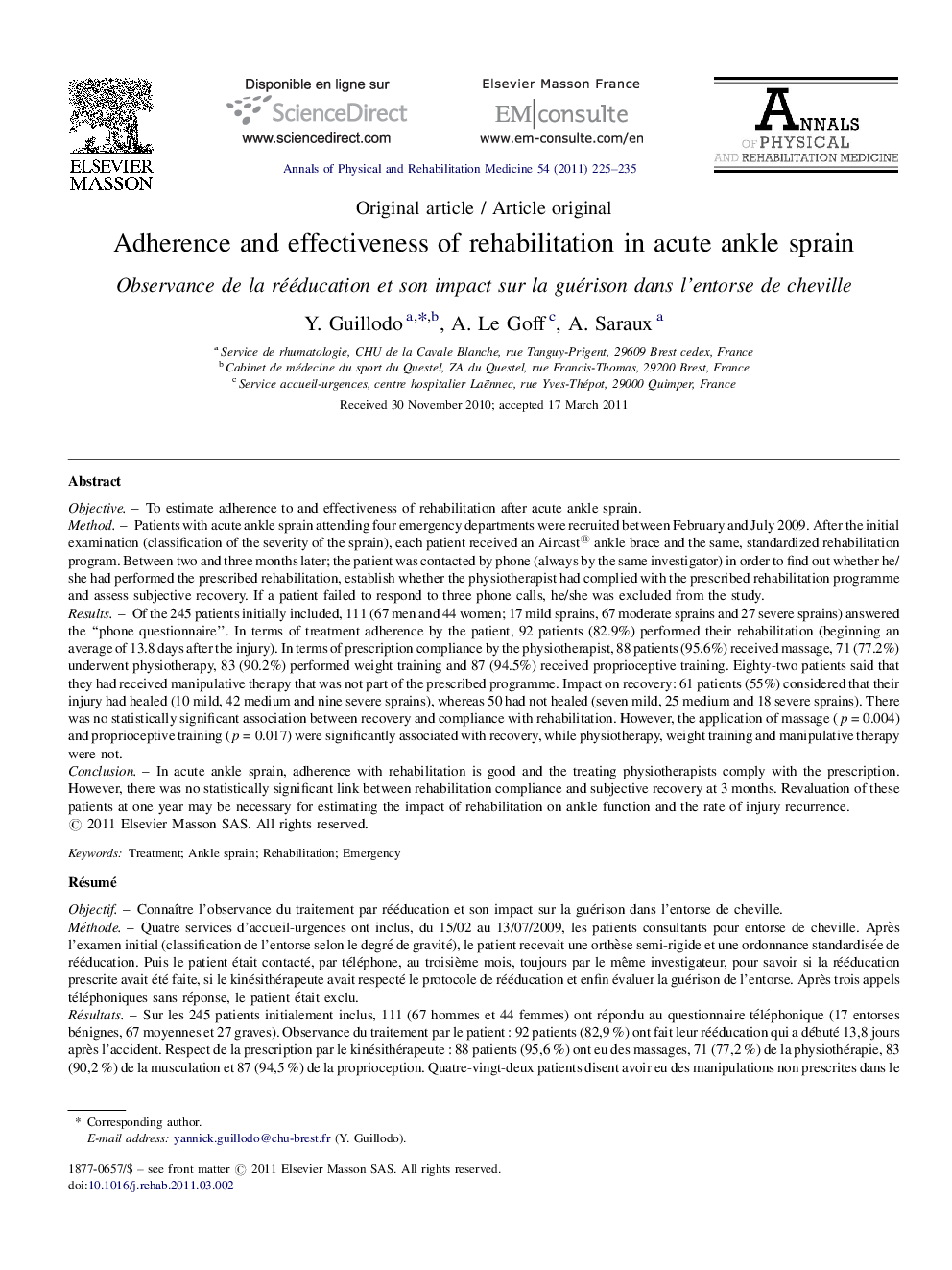| کد مقاله | کد نشریه | سال انتشار | مقاله انگلیسی | نسخه تمام متن |
|---|---|---|---|---|
| 4041256 | 1603337 | 2011 | 11 صفحه PDF | دانلود رایگان |

ObjectiveTo estimate adherence to and effectiveness of rehabilitation after acute ankle sprain.MethodPatients with acute ankle sprain attending four emergency departments were recruited between February and July 2009. After the initial examination (classification of the severity of the sprain), each patient received an Aircast® ankle brace and the same, standardized rehabilitation program. Between two and three months later; the patient was contacted by phone (always by the same investigator) in order to find out whether he/she had performed the prescribed rehabilitation, establish whether the physiotherapist had complied with the prescribed rehabilitation programme and assess subjective recovery. If a patient failed to respond to three phone calls, he/she was excluded from the study.ResultsOf the 245 patients initially included, 111 (67 men and 44 women; 17 mild sprains, 67 moderate sprains and 27 severe sprains) answered the “phone questionnaire”. In terms of treatment adherence by the patient, 92 patients (82.9%) performed their rehabilitation (beginning an average of 13.8 days after the injury). In terms of prescription compliance by the physiotherapist, 88 patients (95.6%) received massage, 71 (77.2%) underwent physiotherapy, 83 (90.2%) performed weight training and 87 (94.5%) received proprioceptive training. Eighty-two patients said that they had received manipulative therapy that was not part of the prescribed programme. Impact on recovery: 61 patients (55%) considered that their injury had healed (10 mild, 42 medium and nine severe sprains), whereas 50 had not healed (seven mild, 25 medium and 18 severe sprains). There was no statistically significant association between recovery and compliance with rehabilitation. However, the application of massage (p = 0.004) and proprioceptive training (p = 0.017) were significantly associated with recovery, while physiotherapy, weight training and manipulative therapy were not.ConclusionIn acute ankle sprain, adherence with rehabilitation is good and the treating physiotherapists comply with the prescription. However, there was no statistically significant link between rehabilitation compliance and subjective recovery at 3 months. Revaluation of these patients at one year may be necessary for estimating the impact of rehabilitation on ankle function and the rate of injury recurrence.
RésuméObjectifConnaître l’observance du traitement par rééducation et son impact sur la guérison dans l’entorse de cheville.MéthodeQuatre services d’accueil-urgences ont inclus, du 15/02 au 13/07/2009, les patients consultants pour entorse de cheville. Après l’examen initial (classification de l’entorse selon le degré de gravité), le patient recevait une orthèse semi-rigide et une ordonnance standardisée de rééducation. Puis le patient était contacté, par téléphone, au troisième mois, toujours par le même investigateur, pour savoir si la rééducation prescrite avait été faite, si le kinésithérapeute avait respecté le protocole de rééducation et enfin évaluer la guérison de l’entorse. Après trois appels téléphoniques sans réponse, le patient était exclu.RésultatsSur les 245 patients initialement inclus, 111 (67 hommes et 44 femmes) ont répondu au questionnaire téléphonique (17 entorses bénignes, 67 moyennes et 27 graves). Observance du traitement par le patient : 92 patients (82,9 %) ont fait leur rééducation qui a débuté 13,8 jours après l’accident. Respect de la prescription par le kinésithérapeute : 88 patients (95,6 %) ont eu des massages, 71 (77,2 %) de la physiothérapie, 83 (90,2 %) de la musculation et 87 (94,5 %) de la proprioception. Quatre-vingt-deux patients disent avoir eu des manipulations non prescrites dans le protocole donné. Impact sur la guérison : 61 patients (55 %) s’estiment guéris (dix entorses bénignes, 42 moyennes et neuf graves) et 50 non guéris (sept entorses bénignes, 25 moyennes et 18 graves). Il n’y a pas de lien significatif entre la guérison et la rééducation. Mais la pratique des massages (p = 0,004) et de la proprioception (p = 0,017) sont des liens significatifs avec la guérison alors que la physiothérapie, la musculation et les manipulations ne sont pas liées.ConclusionL’observance thérapeutique pour la rééducation de l’entorse de cheville est bonne et les kinésithérapeutes respectent bien la prescription médicale. Cependant, il n’existe pas de lien significatif entre la kinésithérapie et la guérison de cette entorse, à trois mois. Il semble indispensable de réévaluer ces patients dans un délai plus long, un an, pour juger l’impact de la rééducation sur le taux de récidive d’entorse.
Journal: Annals of Physical and Rehabilitation Medicine - Volume 54, Issue 4, June 2011, Pages 225–235